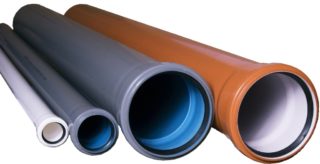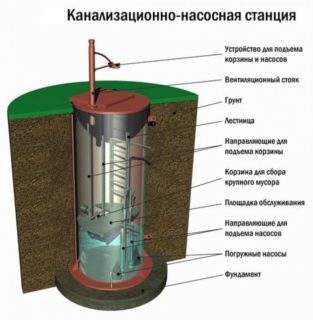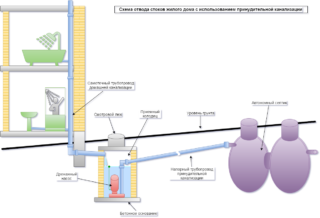An individual sewerage system in a country house, as a rule, is arranged according to the gravity principle. The effluent is sent to the septic tank by gravity under a slope. If, for a number of reasons, it is not possible to arrange such a collector, a sewage system under pressure is required. Such a system forcibly sends wastewater to the collection point using a special pump.
The device and purpose of the pressure sewage system
The sewage pumping station works as a compulsory device for moving wastewater into the receiver and as a storage unit for fecal masses. If a certain level of contaminated water accumulates in the tank, the pump turns on and transports the sewage further to the septic tank or central collector.
Forced sewage is needed in such cases:
- complex rocky terrain of the site, which does not allow laying sewer pipes at a given slope or a complex trajectory of their laying and, as a result, stagnation of sewage on the sections of the path;
- building a house at the lowest point of the embossed area and the location of the central collector above its level;
- the need to install a sewer system from small-section pipes;
- installation of the pipeline by an open method (above the road).
Often, for the device of a pressure sewage system in a private house, a mini SPS (special pump) is installed in the basement floors of cottages immediately behind the toilet. Thus, the drains under pressure reach the gravity section of the individual sewage system. Small stations are called in-house stations. Outdoor sewage pumping stations are mounted outside the house and can serve several objects at once.
Advantages and disadvantages
The pressure sewerage system has a number of advantages:
- When installing it, you can safely use pipes with a smaller cross-section than required by a gravity system. This somewhat reduces the cost of the collector installation process.
- When laying pipes, there is no need to clearly monitor the level of their slope.
- Blockages in the sewer system in the presence of a sewage pumping station are extremely rare.
The disadvantages of pressure sewerage include:
- high cost of SPS, especially if it is outdoor;
- the need to install damping wells to relieve excessive pressure in the system (for stations serving several houses);
- installation and maintenance costs of the pump station.
With a properly installed pump, the sewer system will work without interruption for decades. You just need to regularly clean the main tank.
Actual requirements
- SPS is installed only in rooms with a positive temperature. If it is an outdoor station, it is insulated with high quality.
- When designing the system, it should be borne in mind that the pump must be accessible from all sides, and the site must accommodate the foreman in case of repair / maintenance work.
- The collector from the pump to the waste receiver is made without sharp turns and distortions.
- A special support elbow for sewer pipes is installed at the bottom of the sewage pumping station.
- Tubes for a discharge manifold must be flexible, have good linear elongation, withstand pressure drops and ensure reliable tightness at the joints.
- According to SNiP, the collector of the outer part of the sewage system is laid below the level of freezing of the soil or it is well insulated.
- To prevent the backflow of sewage, a gate valve and a check valve are installed.
If the installation of a combined sewage system is envisaged, pressurized pipes are installed after the pump. Before him, it is possible to install conventional tubes.
Choice of pipes

For the installation of a sewage system operating under pressure, it is necessary to use pipes that meet the following characteristics:
- good flexibility;
- resistance to pressure drops;
- increased tightness at the joints.
Cast iron and polymer pipes have these properties. The first ones are not used so often because of their large mass, relative fragility in the cold and the laboriousness of their installation.
An excellent option for installing pressure sewerage are PVC or HDPE pipes. They have the following advantages:
- inertness of the material to aggressive media;
- light weight;
- smoothness of the inner walls, which prevents silting of the collector / adhesion of fecal waste to its walls.
Polymer pipes are joined using a simplified connection technology.
Installation steps
Work on the installation of the pump station is carried out in the following sequence:
- Determine the location of the pump. As a rule, it is mounted at the lowest point of the sewer.
- The fasteners supplied with the pump are installed on the prepared site.
- Mount the device itself and check the reliability of its position. SPS should stand level, without distortions and forced turns relative to the inlet / outlet of the collector.
- The supplied rubber hoses are connected to the pump inlet / outlet.
- The hoses are connected to the collector pipes using special fittings.
- All joints are additionally treated with a sealant.
- The assembled system is connected to electricity.
The SPS storage device must have some spare volume in case of a power outage. It is good if this volume allows you to accumulate drains for at least three days, or you need to install an autonomous generator in the house.










